
Alan Murton brings us yet another of his literary gems. Not this time from Truro but from a small community just down the road, a place which clearly tugs at his heart strings.
Every Cornishman has his favourite places and one thing is certain we’re spoilt for choice. Don’t ask how I choose mine. I couldn’t tell you how, when or why my list is as it is, or how I rank them, like my father used to say: “There’s no bad beer boy – just some’s better’n others”. Many date back to happy childhood memories, a few are more recent and the list is still growing.
Malpas is very high on my list yet it took until our second pilgrimage there since coming home for me properly to identify the three key factors that make it so magic for me. There is only one road that leads to the village and it follows the Truro River. You will pass Boscawen Park where the Truro Cricket Club has its ground and where there are colourful gardens and open parkland, an amenity that reflects great credit on the city council gardeners. On the left are the water gardens which are home for so many swans that the locals have always called it the “Swan Park”. A little further and the road narrows at Sunny Corner, where there used to be changing rooms for the bathers who swam in the river in simple, unpolluted days.
You pass through an avenue of tall pines and arrive almost by surprise at the entrance to the village but be warned, the village street is narrow and the road runs out at the yacht club. Parking is limited and the bus drivers get stroppy if you leave your car in their turning bay. Take the first spot you can and walk – there’s a lot to be said for leaving your car at Boscawen Park and enjoying a stroll along the riverbank.
The village sits on a bluff above the junction of three rivers where the Tresillian and the Truro rivers merge to become the Fal – the “Cornish Danube”. I love it as a place of great natural beauty; the banks on both sides are clothed in shrubby oak trees and further down the Fal’s journey to the sea you can still find the odd Kea plum and by King Harry Ferry, indigenous conifers as well. The oaks cover the banks in smooth curves and the branches of the lower ones dip to and overhang the water.
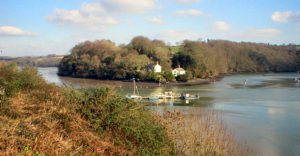
St Michael Penkivel is perched on the opposite bank and a sparkling white house dominates the waterfront. That’s where the ferryman used to live who provided the service from the village to Malpas and its ‘bus to Truro. He pulled his rowing boat across the couple of furlongs of tidal water that separates the two. The ferry still runs, it’s motorised now, but passengers on either side still summon it by the brass bell on the slipway.
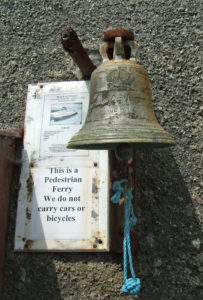
St Michael Penkivel has a fine church with some interesting brasses. The leafy lanes offer a gentle stroll through the pastureland, past pretty well-tended cottages to the church or to the home farm where generations of the same family have grown daffodils and narcissus on Lord Falmouth’s land.
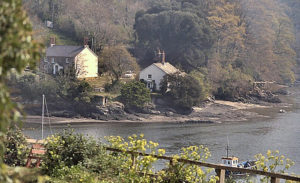
In sunshine the whole scene sparkles with life. A variety of boats in fresh white paint are moored to colourful buoys, their sleek lines reflected in the still water. Yachts and motor cruisers, lifeless now, seem to be waiting for a crew to bring them to life. Even under winter cloud when the rivers have their own dull green sheen the surface is almost always mirror still. Sea birds wheel over the water and if you’re lucky you can sit on the terrace of “The Heron” and watch the cormorant diving to fish or perch on a buoy and hang his wings, half spread, to dry.
The second part of my love for Malpas is personal because in the late war years and after, I spent weeks of my summer holidays in an aunt’s cottage in Scobles Terrace, perched above the only road in the village. All my waking hours were spent in games and play by or on the river and the sun shone every day. With children from local families I fished for tiny crabs, dangling open cockleshells tied to pieces of string in the shallow water, often from the stem of a boat half-beached by the slipway. We’d release them on the stony foreshore and watch them scuttle back to the river.
On a good day we’d be allowed the use of a rowing boat or a praam, a rudderless boat of Dutch origin with a square bow that was high out of the water. It was easy to pull but difficult to hold straight in a strong wind. Sometimes our rowing outings were courtesy of the owners of a yacht who’d come ashore in their dinghy to re-stock the galley or refresh themselves in the Malpas Inn.
A popular recreation for Truro families was taking a picnic down the river to Coombe Creek or Turnaware Bar, perhaps fishing with a hand line around the Royal Navy or merchant ships moored in the deep anchorage at King Harry Reach. The last time I went (with friends from Kenwyn Youth Club including Pat, my wife) we shared the eight shillings (40 pence) hire charge for the boat.
Malpas has changed little over the years. Its inherent beauty has been retained even though more houses and the Yacht Club have been built; mostly beyond the slipway on the fields we once walked to St Clement’s. There is a complex of luxury flats on the bank below Scobles Terrace but there is still a village store where it always was.
The houseboat has long since rotted: it was home to Ernie Cocks, a well-known local eccentric, whose boat building and repair skills were second to none. Gone too are the thin poles that marked the many oyster beds, victims of ignorance and pollution.
Today it is the “MV Enterprise” not the steamship “Queen of the Fal” that takes day-trippers to Falmouth and back from Truro’s Lemon Quay (or at low tides from the wooden pier at Malpas).
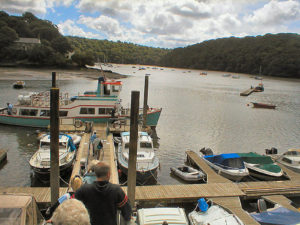
The “Queen” was requisitioned in the 1939/45 war. I last saw her moored in Truro where Tesco’s customers now park their cars; her mission was to raise funds for the war effort. Her red and black livery was hidden under battleship grey but her proud little smokestack still carried a band of scarlet. She was armed with a 6-pounder and “Pom-Pom” anti-aircraft guns but I don’t know whether they were ever fired in anger.
For all that, when I take my beer on to the terrace of “The Heron” (formerly the Malpas Inn) I see the same breathtaking scenery that I carry in my memory. Perhaps there are fewer boats moored now and fewer buses on the service from Truro although on my visits I don’t see or hear children at play. Maybe the village too has grown old.
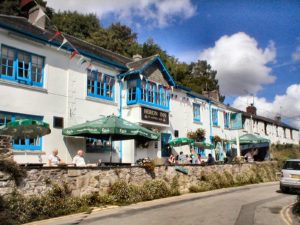
The third and perhaps most weighty element in my love for Malpas is in the sheer tranquillity that adorns the place. Lack of parking and “touristy” facilities ensure that it is not over-populated with visitors or internal combustion engines. I have had lunch outside the pub and soaked up the sun for over an hour and heard only songbirds celebrating the summer or sea birds calling. Peace and natural silence is a rare luxury these days. If you get a hankering to discover it for yourselves please don’t spoil it for me.
Malpas A Favourite Place
Pause a while and share this seat
High on the bluff in Malpas village,
It’s where three Cornish rivers meet.
When the sun reflects from the flowing tide
Where else on earth would you want to be
With like-minded friends at your side?
In a silence so rich you could almost cry,
Just lapping water and the song of the birds
As the cormorant hangs out his wings to dry.
The house of the ferryman across the river
Is decked with years old Virginia creeper
The boats afloat sit still without a quiver.
The banks are clothed in shrubby trees
Decked bright green in their Spring-time leaves
Set a-rustling by the lightest breeze.
Their branches dip to the ebb and flow
But passing time is relentless alas
Time now to leave it behind and go.
Rest assured that I’ll come again
To my heaven on earth – luxuriant peace
Whether it be in sunshine or in rain.
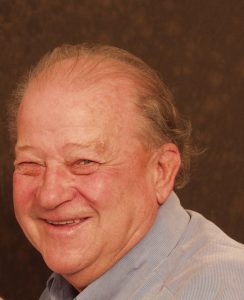
Truro born and educated Alan Murton returned to Cornwall in 1994 with Writing as a key aim in early retirement after a course with Open College of the Arts with Cornish poet Philip Gross as his mentor. He sent some of his writing to Cornwall Today and was soon a regular in its pages until the West Briton took it over. He joined Truro Creative Writers in 1995 and worked with them, for 20 years as Chairman/Secretary.
Apart from competing in Old Cornwall Society competitions he wrote for two subscription magazines and has been published nationally as well as locally.

Lovely memories – one of my favourite places too.
This brings back a lot of memories, the cottage that Alan refers to is where I was born. The “AUNT” referred to was my mother and this was very much home.
A very good summary of the place, but the name of the pub then was The Park Hotel, named after the large farm called naturally enough Park Farm.The writing is superb and I can envisage the whole aura by it.
What a lovely article. Following the recent passing of my husband, I was taken out to lunch for ‘a change of scenery’ . When I read this article I wanted to share some of it in a blog post. I have acknowledged the writer and hope it hasnt infringed copyright.
No problem, Barbara, and thanks on Alan’s behalf.